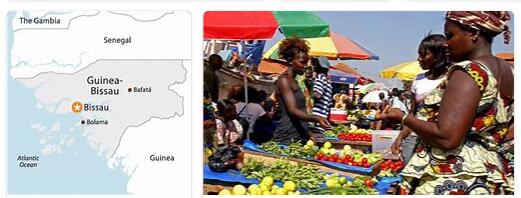Politics
According to the constitution of May 16, 1984, which has been amended several times, Guinea-Bissau is a presidential republic with a multi-party system. The head of state, commander-in-chief of the armed forces and supreme owner of the executive is the president, who is directly elected for a period of 5 years (one-time re-election possible). He appoints the prime minister and the other members of the cabinet, has a right of veto in the legislative process and can impose a state of emergency. The legislature lies with the National People’s Assembly (Assembleia Nacional Popular), whose 102 members are elected for 4 years (right to vote from the age of 18; 2 seats are reserved for citizens living abroad).
National symbols
The national flag in the African colors is horizontally striped yellow over green, with a red stripe on the leech one third of the total width; in the middle of the red field the five-pointed black star of African freedom.
The coat of arms adopted in 1973 shows a golden shell from which palm branches sprout; above the black star of African freedom. The motto on a red ribbon: “Unidade, Luta, Progresso” (unity, struggle, progress). The shell is reminiscent of the Cape Verde Islands, the palm branches stand for Guinea-Bissau, the star symbolizes the PAIGC freedom movement.
The national holiday is September 24th, it commemorates the proclamation of the independent republic in 1973.
Parties
Important parties are the Partido Africano da Independência da Guiné e Cabo Verde (PAIGC; former Unity Party), the Partido da Renovação Social (PRS) and the Partido Republicano para a Independência eo Desenvolvimento (PRID).
Education
The school system is based on the Portuguese model and is divided into a six-year elementary school and a five-year secondary school. There is general compulsory schooling from 7 to 13 years of age, but the enrollment rates are low (primary level 2006: around 45%, secondary level less than 10%). The first university (Amilcar Cabral in Bissau) was founded in 2003.
Media
The freedom of the press is threatened by state intimidation and self-censorship.
Press: The main daily newspapers are “Noh Pintcha” (government), “Diário de Bissau”, “U ltima Hora” and “Banobero”.
News agency: Agência Noticiosa da Guiné (ANG).
Radio: TV programs are broadcast by the state company Radio Televisão da Guiné-Bissau and “RTP África”, a subsidiary of the public service broadcaster in Portugal (RTP) for the Portuguese-speaking countries of Africa. In addition to the state radio broadcaster “Radio Nacional” there are a few private and local radio stations, especially in the greater Bissau area.
Economy
Business
Guinea-Bissau belongs with a gross national income (GNI) of (2017) US- $ 660 per resident to the poorest countries in the world and is highly dependent on development aid and international loans. Over half the population lives below the poverty line on less than US $ 1 a day. After independence, the government tried to develop the economy through a centrally organized modernization program. However, this failed, as did the introduction of the market economy at the end of the 1980s due to international pressure from donors. The economic structure is dominated by agriculture (especially rice cultivation) and fishing, which (2014) contribute 43.9% to GDP. 42.5% is generated by the service sector, 13.6% by industry and construction. The foreign debt was reduced by debt relief from over 1 billion US $ to (2015) around 217 million. Visit weddinginfashion for Economy of Western Africa.
Foreign trade: Foreign trade has been characterized by a negative trade balance since Guinea-Bissau’s independence in 1973 (import value 2016: US $ 221.8 million; export value: US $ 164.4 million). The most important export goods are cashew nuts, fish, palm kernels, rubber and wood. Almost all consumer goods and industrial equipment as well as petroleum products and food are imported. The main trading partners are India, China, Portugal and Senegal.
Agriculture
Over three quarters of the population live from agriculture and livestock farming, which are mainly used for self-sufficiency. The main food, rice, is grown mainly in the south and west, which is rich in rainfall. In the east, corn and millet dominate alongside cassava, sweet potatoes and vegetables. However, food has to be imported to supply the population. Export products are cashew nuts (cultivated on the plateaus in the eastern part of the country), palm oil, coconut and peanuts.
Forestry: The forest, which still covers 70.5% of the country’s area, consists mainly of inferior secondary forests and is increasingly being reduced by slash and burn, logging for export and firewood.
Fisheries: Inshore fishing (fish and crustaceans for export) has been modernized in recent years and makes an important contribution to feeding the population. In addition, fishing licenses, which represent an important source of foreign exchange, were mainly issued to Portugal, Spain, France and Japan.
Natural resources
The existing mineral resources (bauxite, phosphate, diamonds and gold) are not yet mined due to high investment costs and insufficient infrastructure. Oil and natural gas sources in the offshore area are still being explored.
Industry
The industry is limited to the processing of agricultural goods such as rice, cashew nuts, palm kernels, cotton and wood as well as the production of schnapps.
Tourism
Guinea-Bissau is one of the least known travel destinations in Africa, and tourism is still an almost undeveloped sector (around 30,000 foreign visitors annually). The offshore islands (e.g. the Bissagos Islands) and the dense rainforest areas in particular offer tourist potential.
Transportation
The road and path network (a total of around 2,800 km, over a quarter of which is asphalt) is poorly developed and there is no railway line. With the exception of the northeast, however, Guinea-Bissau has good inland waterways with many medium-sized and small moorings. The four largest river ports and the most important sea port Bissau were expanded and modernized. There are ferry connections across the rivers to the south and north. The international airport Bissalanca is located near the capital Bissau.
